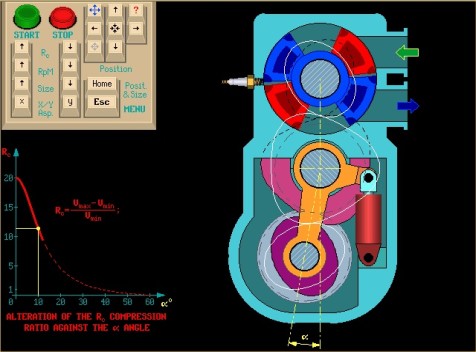Free DOS software from Falcosoft
|
|
 |
In case you would like to support Falcosoft to continue developing free software, you can donate here through PayPal.
If you can't afford online payments but you like any of the software, click to promote them on Facebook and Google+.
Thanks in advance.
All of the programs are MS-DOS and FreeDOS compatible and require no installation.
Pascal Programs
|
My father's vision of a new type of engine that is non-existent at present. Detailed documentations can be found in the zip file.
Warning! The program uses full screen SVGA graphics so running it under Vista/Win7 with a WDDM graphics driver installed is not possible. However virtualization software is supported, moreover DOSBOX is a good alternative solution too.
Or you can try the program online. (JDosBox is java based and rather slow.)
Rotary Engine - running as Java applet inside the browser.
|
|
|
The program enables power saving low power states of your Athlon64 based processor (including mobile Turion, Sempron) under DOS. Warning! Don't use this program when EMM386 is loaded! If you need EMS use JEMM386, if you only need more conventional memory use UMBPCI instead.
Usage: A64LOWP [multiplier] [voltage] -without parameters shows CPU info The order of the parameters are mandatory. You can use number only forms too.
A64LOWP does not require BIOS generated Performance State Block or ACPI-defined P-state objects, and every combination of frequency and voltage can be set (of course not every combination will work...). A64LOWP 10x 1.1v --sets 2000 MHz 1.1v
The theoretical minimum and maximum values defined by AMD:
version 1.1 Added partial support for Athlon 4/Athlon XP Mobile. More info can be found in the A64Lowp.txt file.
Source code is included (Turbo Pascal 6+,TPC16 Syntax)
|
 |
|
The program lets you change the working frequency and voltage(ID) of your Intel Speedstep capable processor under DOS. Mostly single core Pentium M, Core Solo, and Atom processors are supported.
1. First run the program without any argument. 2. Look at the output. The program checks for Speedstep support by checking feature bit. If it's not set then you get 'CPU not supported'. No further things to do :) 3. If Speedstep is supported then you get the current, and possible minimum, maximum values. So you can run the program with the necessary 2 arguments: FID (multiplier), VID (processor specific voltage id). You shuld try values given in the minimum/maximum range. If p-state transition succeeded then you should see the LastTriedFid/Vid and CurrentFid/Vid values are equal. If not then likely the LastTriedFid/Vid values are the ones you defined, but CurrentFid/Vid are unchanged. This situation can be attributed to flawed multi core logic of Speedstep. In this case you should lower your initial p-state in BIOS. Further information: Freedos mailing list on sourceforge.net
Source code is included (Turbo Pascal 6+,TPC16, FPC32) |
 |
Assembly Programs
|
MSKVBEF7 is a TSR that masks/hides VESA VBE Function 07h - Set/Get Display Start.
E.g. Quake 1 and Build engine games such as Duke Nukem 3D, Blood and Shadow Warrior are definitely affected by this bug.
|
|
|
Enables power saving low power states of your Turion64 mobile processor under DOS.
Warning! Don't use this program when EMM386 is loaded! If you need EMS use JEMM386, if you only need more conventional memory use UMBPCI instead.
|
|
|
Sets the low power performance states of Phenom, Phenom II CPU under DOS. Warning! Higher p-state means lower performance! Don't use this program when EMM386 is loaded! If you need EMS use JEMM386, if you only need more conventional memory use UMBPCI instead.
PWR without parameter shows current frequency in MHz and current P-state
Source code is included (TASM,JWASM Syntax).
version 1.2
|
|
|
Shows you the processor speed based on the Time Stamp Counter(TSC) register of your processor.
Source code is included (TASM,JWASM Syntax).
|
|
|
FVID enables the write combining feature of modern processors on the linear frame buffer of the Video card. This can speed up Video performance of graphics appliacations under DOS.
Warning! Don't use this program when EMM386 is loaded! If you need EMS use JEMM386, if you only need more conventional memory use UMBPCI instead.
Source code is included (TASM,JWASM Syntax).
version 1.2
|
|
|
CACHE allows you to disable your processor's cache hierarchy in DOS, virtually transforming your processor to an old 386.
Warning! Don't use this program when EMM386 is loaded! If you need EMS use JEMM386, if you only need more conventional memory use UMBPCI instead.
Source code is included (NASM Syntax)
|
|
|
Fakemem is a tool to report only 4MB of video memory under DOS to programs that are not ready to handle situations where the size of the video memory is huge.
Source code is included (TASM,JWASM Syntax).
|
|
|
DPMS for DOS is to activate the power saving feature of your monitor under DOS, if it supports the
Source code is included (TASM Syntax).
|
|
|
Simply enables the SSE(2,3) instruction sets under pure DOS, Win31, or Win95.
Warning! Don't use this program when EMM386 is loaded! If you need EMS use JEMM386, if you only need more conventional memory use UMBPCI instead.
|
|
|
A simple Mandelbrot set with 150 maximum iteration in 1024x768x8 VESA SVGA fullscreen graphics mode. Source code is included (TASM Syntax).
|
| Jump to Top |

